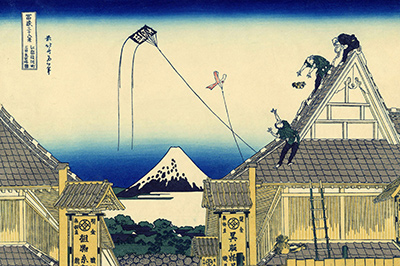Mitsui shop in Suruga in Edo is the eleventh print in Katsushika Hokusai’s (1760-1849) series of thirty-six woodblocks that feature Mount Fuji in the background. Hokusai’s career began at age 14 as the apprentice of a woodcarver.
For the remainder of his life, he created woodblock prints in a variety of artistic traditions and he produced this woodcut series when he was nearly 70, possibly as a meditation on the transience of life. In Hokusai’s most famous woodcut, The Wave, we see boaters in peril as a tsunami veers towards them. In the background, the presence of the volcanic peak reminds us that the mountain will be there long after everything else is gone.
The subject matter of Mitsui shop in Suruga in Edo is unusual, the name of the print referring to a retail outlet for the Mitsui company in Suruga Street in Edo, which is now a part of Tokyo. Japanese artists did not embrace the grand manner of the artists of the west, that is, painting mainly scenes from mythology and history. In contrast, Japanese artists depicted the enjoyment of everyday activity and the beauty of nature in favour of man-made grandeur. The image is not intended as a photographic “still” but requires the viewer to read it as a journey from turbulence to calm. The mountain acts as a centre of gravity in the frenetic environment.
In Mitsui shop in Suruga in Edo, human figures create a giddy sensation with their kite-flying antics on the sloping roof. The image is “off centre”, that is, more building is on view on the right of the print than on the left. Mount Fuji does not occupy the exact centre between the two building wings. In classical western art, this would be seen as erroneous, but here it is a device to ensure we read the image correctly. Japanese images are read from right to left and our eyes travel from the prominent human figures to the slightly-receding mountain.
The abruptly cut-off building on the left of the image requires the viewer to move onto another image to continue the story. Other typical Japanese devices include the strong diagonal and vertical lines, the hatchings that create texture and the use of bright blues and yellows to create perspective. Mitsui shop in Suruga in Edo is a meditation on the transience of human activity, and upon the power of nature and eternity.




